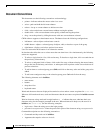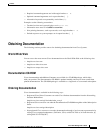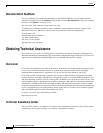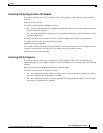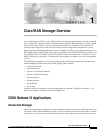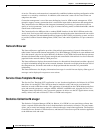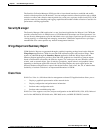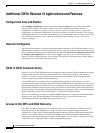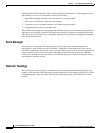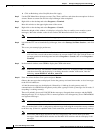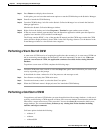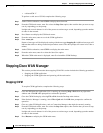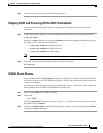
1-4
Cisco WAN Manager User’s Guide
Version 10.5, Part Number 78-12945-01 Rev. D0, August 2003
Chapter 1 Cisco WAN Manager Overview
Additional CWM Release 10 Applications and Features
Additional CWM Release 10 Applications and Features
Configuration Save and Restore
The ConfigSave and Restore feature can be found under the Tools pull down menu of the CWM
Topology Main Window. This feature enables you to save a snapshot of the entire network’s
configuration on CWM. In a disaster recovery scenario, you can selectively restore a single node’s
configuration, or restore the configuration of the entire network on a node by node basis. This feature
significantly reduces time to recover in the unlikely event of a catastrophic failure. You can also use the
Save and Restore feature to restore a previous configuration after making a series of incorrect or
temporary changes.
Network Configurator
The Network Configurator is a new Java-based application for Release 10 of CWM that enables users to
add new nodes, or modify or delete existing nodes. It is also used to provide descriptor information, node
name, and IP address information for the nodes in your network. The Network Configurator is started
by entering runConfigurator <machine name> <login> <password> on a shell’s command line,
where Cisco WAN Manager Release 10 is installed. The Network Configurator main window appears,
allowing the user to add, delete, and modify nodes.
CWM to CWM Communications
Release 10 of Cisco WAN Manager has been designed to enable multiple CWM workstations to manage
a network with improved network synchronization and scalability. Due to the size and growth of
networks, it is faster to retrieve initial network information from another CWM workstation that is
already running and synchronized with the network.
A new CWM feature now enables users to continue the provisioning of network data, even when
communications between a Primary CWM and Secondary CWM have been interrupted. If for any reason
the communications between CWM servers are interrupted, user data provisioning will be suspended on
the Secondary CWM, but user data provisioning will continue on the Primary CWM. During that time,
the provisioning of user data and monitoring of the network are not impacted. This is called the Degraded
Mode of Operation, and is discussed in Chapter 11, CWM-CWM Communications.
Release 10 of CWM uses an industry standard CORBA architecture to implement the communications
between two or more CWM workstations. The architecture uses a server-client structure for
communications between the CWM server and client processes.
Access to IGX, BPX, and MGX Networks
IGX, BPX, and MGX switches provide an Ethernet 802.3 AUI LAN interface to CWM for network
management control and information. An entire network can be managed through an Ethernet
connection on a single WAN switch or through multiple Ethernet interfaces distributed throughout the
network. Cisco WAN switches use TCP/IP over Ethernet to communicate between CWM network
management workstations and the WAN switch. Telnet support is also available to enable LAN-based
workstations access to the IGX, BPX, or MGX management interface.



